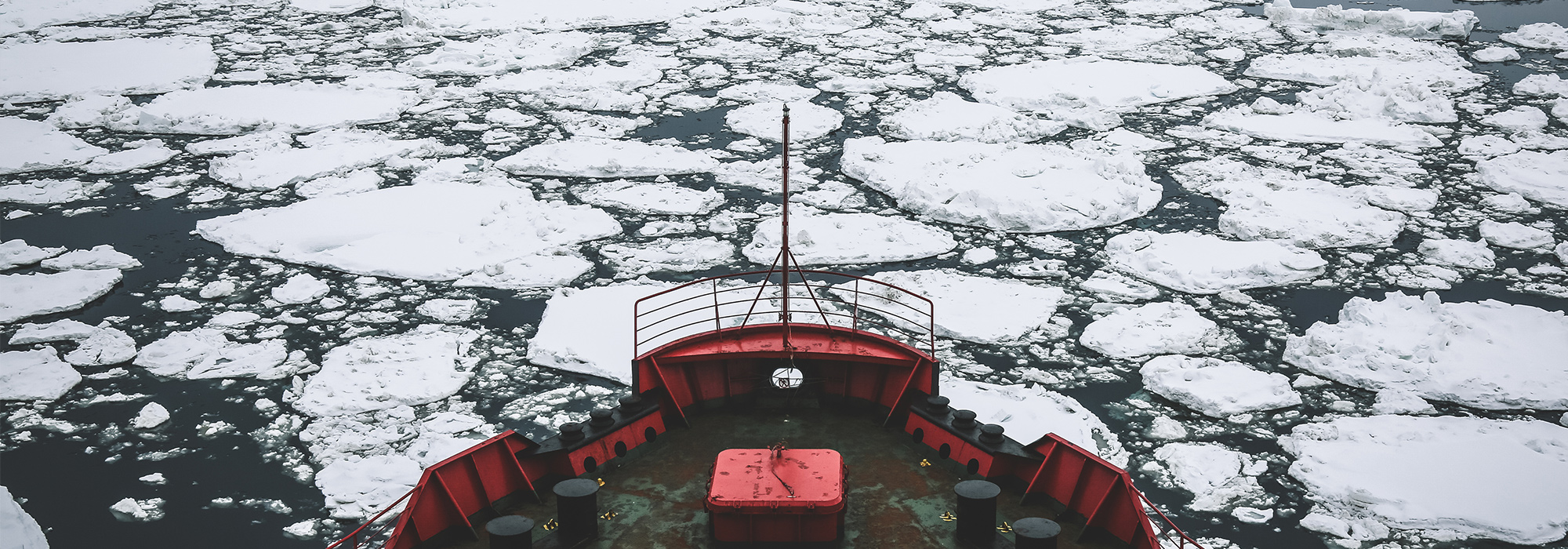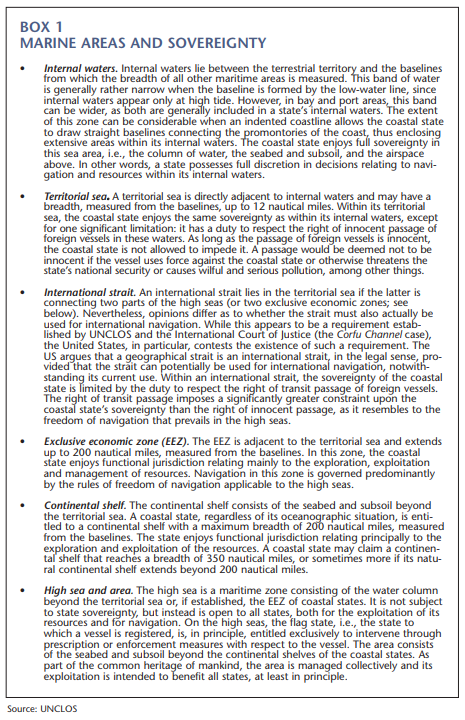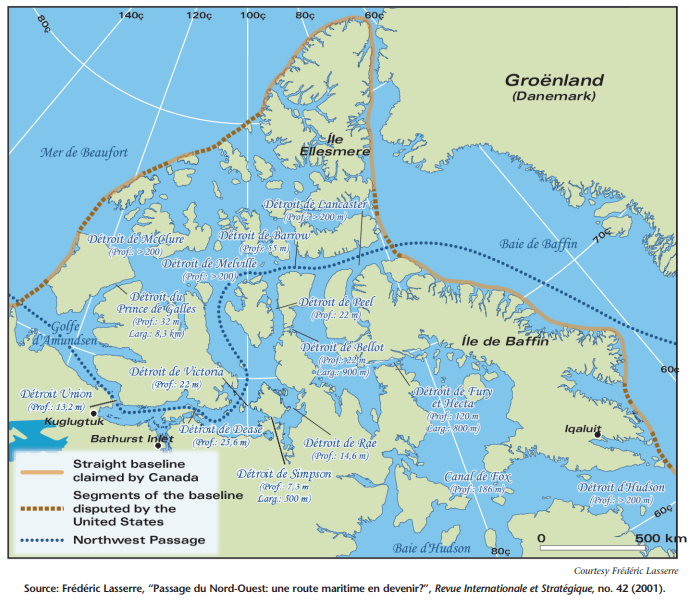
“Canada has a choice when it comes to defending our sovereignty over the Arctic. We either use it or lose it. And make no mistake, this government intends to use it. Because Canada’s Arctic is central to our national identity as a northern nation. It is part of our history. And it represents the tremendous potential of our future.”
With this declaration in 2007, Canadian Prime Minister Stephen Harper launched his campaign to reinvest in the Far North, both politically and economically. This statement implies that Canada must choose whether to use its sovereignty, at the risk of losing it. It is questionable whether Canada is actually forced to choose between using and losing its sovereignty. The declaration could be a merely political slogan that conveys the interest of Canada’s politicians in the Arctic or, worse, it could even imply a legal interpretation that could negatively affect claims on Canadian Arctic waters.
This article addresses these questions by examining the state of law, including customary law and the rules of the UN Convention on the Law of the Sea (UNCLOS) and the relevant jurisprudence of the International Court of Justice (ICJ). Indeed, Canada, along with its circumpolar counterparts, recently recognized — through the Ilulissat Declaration made in 2008 — that the rules set forth by international law must be observed. A two-step analysis addressing the issues of resources and navigation will provide an opportunity to determine if the “Use it or lose it” slogan is appropriate and wise in the context of legal issues relating to sovereignty in the Arctic.
At the outset, it is worth recalling several facts regarding Canada’s legal situation in the Arctic. Prior to 2003, customary law and the 1958 Geneva Convention on the Continental Shelf were the only sources of law applicable to the Canadian Arctic, as Canada did not become a party to UNCLOS until then. Since 1970, Canada’s territorial sea has had a breadth of 12 nautical miles, and Canada claims the waters of its Arctic archipelago as internal waters. As of 1986, this claim, previously justified by an uncertain historic title, is based on straight baselines drawn around the archipelago. Canada also contests that the Northwest Passage is an international strait, as the United States asserts. Like all other states bordering the Arctic Ocean, Canada is currently collecting evidence that its continental shelf extends beyond 200 nautical miles.
This said, it is important to underline that Canada’s sovereignty over the Arctic mainland and islands is unanimously recognized, with Hans Island being the only exception. This is remarkable as, despite the word “island” in its name, Hans Island is nothing more than a small, uninhabited and uninhabitable rock situated between Canada and Greenland. Its only significance is political in nature, as neither Canada nor Denmark wishes to abandon its claim over it. Apart from Hans Island, there is no disputing that the vast land area in the Canadian Arctic is subject to Canadian sovereignty.
Yet a sovereign state does not lose its sovereignty over a territory simply because its administration is limited or nonexistent in some areas. This is especially true in the Canadian Arctic, which is an inhospitable environment, and one where human presence is often limited in time (for the duration of an employment contract) or requires extraordinary adaptation to cope with harsh climatic and meteorological conditions (Inuit people). Usucaption, the complete and prolonged abandonment by one state combined with its takeover by another state, is the only situation in which one state may eventually lose its sovereignty over a given territory to another state. At this point, there is no threat of usucaption of Canadian Arctic territory.
The concern of losing sovereignty in the Arctic is thus related rather to marine territory. This includes the waters off the Canadian Arctic coasts — especially the Northwest Passage, a set of seaways through the Canadian Arctic Archipelago — as well as the submerged parts that form the continental shelf and particularly the continental shelf beyond 200 nautical miles.
As the ICJ said in the Anglo-Norwegian Fisheries case, “It is the land which confers upon the coastal State a right to the waters off its coasts.” The waters referred to are the internal waters; the territorial sea, which can sometimes form an international strait; and the exclusive economic zone (EEZ). The same reasoning applies to the continental shelf that completes the sea areas off the states’ coasts. Box 1 briefly describes each marine area, as defined by UNCLOS, which must be distinguished in order to understand whether and, if so, to what extent the coastal state must exercise its sovereign powers over resources, navigation and maritime areas to preserve them.
It is important to underline that Canada’s sovereignty over the Arctic mainland and islands is unanimously recognized, with Hans Island being the only exception. Apart from Hans Island, there is no disputing that the vast land area in the Canadian Arctic is subject to Canadian sovereignty.
The powers of the coastal state over these areas vary as a result of the different ways states’ conflicting interests in the oceans have been reconciled. Evidently, coastal states claim power over the waters bordering their coasts principally for reasons of national security and to benefit from the resources to be found in them. However, other states may have a legitimate interest in these resources to, for example, ensure food security and contribute to their economic development. In addition, these other states claim the right to use the seaways with proximity to the coasts, given their strategic and economic value.
So does Canada risk losing its sovereignty over resources in the Arctic if it does not exercise its powers?
Relating to resources, the situation is clear with regard to the continental shelf. The sovereign rights of a coastal state over this marine area do not depend on occupation, effective or notional, or on any express proclamation” (article 77 of UNCLOS). In other words, the entitlement of the coastal state over its continental shelf is automatic. Moreover, a state’s sovereign rights are “exclusive in the sense that if the coastal state does not explore the continental shelf or exploit its natural resources, no one may undertake these activities without the express consent of the coastal State” (article 77 of UNC-LOS). This signifies that even if Canada decides not to exercise its sovereign rights (exploration and exploitation of its continental shelf), this will not result in any loss of its rights. This also holds true for the extended continental shelf that stretches beyond 200 nautical miles.
Certainly, Canada must prove, in accordance with the geological and geomorphological criteria set by UNCLOS, that the extended continental shelf is part of its territory. In order to benefit from the legal certainty provided by UNCLOS, Canada has to base the outer limits of its continental shelf on the recommendations of a United Nations committee. Canada must submit the justifying data to the committee by 2013 and has been gathering it for several years now. Nevertheless, should Canada abstain from benefiting from an extended continental shelf, another state is not entitled to make a claim over it in its place. The rules are intended to ensure that each state has jurisdiction only over “its own” extended continental shelf. Yet, once the extent of its shelf has been determined according to the applicable rules, Canada is granted sovereign powers with regard to the exploration and exploitation of the resources, including the decision, for reasons of economic efficiency, not to take advantage of them.
In contrast to the continental shelf up to 200 nautical miles, the EEZ must be established by the coastal state prior to the enjoyment of its sovereign powers over its resources. Canada established its EEZ through its Oceans Act. Given the importance of its living resources, UNCLOS requires optimum utilization of the EEZ, while respecting the conservation of the stocks. If a state does not have the capacity to yield the entire volume by itself, it shall give other states access to the surplus. In the case of little or no surplus, the developed coastal states shall ensure, by agreement, the participation of the same region’s landlocked or geographically disadvantaged developing states in the exploitation of those resources.
If Canada chooses not to exploit its living resources, it will not forfeit its sovereign right to do so. Nonetheless, it must ensure that these resources are not lost and can still be used to benefit other states, notably developing states. In contrast, if it chooses to fully exploit the available volume, it is de facto protected from claims by the aforementioned states to participate in the exploitation process, as no such states seem to belong to Canada’s region.
With regard to the authority to regulate navigation in the Arctic, does Canada risk losing its sovereignty if it does not exercise its powers? In this case, the Canadian Arctic Archipelago is at the heart of the concerns. The situation is complicated by the fact that, unlike in other Canadian Arctic regions, including the Beaufort Sea, the status of these waters is uncertain. Working with different scenarios is thus required in order to elucidate all aspects of the problem.
The first scenario to be analyzed is the US position concerning the Canadian Arctic Archipelago, a position that is strongly opposed by Canada. According to Washington, the waters of the Canadian Arctic Archipelago are considered territorial waters, suggesting that they cannot be qualified as internal waters, through either historic title or straight baselines. In its territorial sea, Canada, although it is sovereign in all other aspects, must observe the right of innocent passage of foreign vessels, which limits its legal power to regulate international navigation, since it has no right to hamper innocent passage. However, the perpetuity of a state’s sovereign rights in its territorial sea is unaffected by the decision to not exercise them. A state’s decision not to regulate navigation — or not to exploit resources — within its territorial sea is not grounds for losing sovereign rights over the area.
Given the geographical situation of the Canadian Arctic Archipelago, some of its parts — namely, the Northwest Passage — might qualify as an international strait, which would greatly limit Canada’s powers over these waters. According to the American interpretation, the passage is basically suitable for international navigation and thus qualifies as an international strait. Canada argues, with support from the predominant literature, that current international navigation is necessary and points to the fact that it is, for the moment, virtually non-existent in the Northwest Passage.
Until recently, the passage was protected by heavy ice conditions most of the year, thus making the archipelago unattractive for international navigation, although its use in the right conditions can significantly shorten some intercontinental routes. Yet, even though navigation is still dangerous due to drifting ice, shallows, currents and fog, the retreat of the ice, combined with increased economic activity in the region, is making the archipelago more attractive.
An important element of Canada’s argument is that all foreign shipping in the archipelago is under Canada’s supervision through NORDREG, the Canadian vessel reporting system for the Arctic, mandatory since July 2010. It is judicious for Canada to proactively regulate and monitor the navigation in these waters and to require foreign vessels to report to Canadian authorities. In so doing, it would be easier for Canada to support its contention that there is no “international navigation,” but only some navigation of foreign vessels under Canadian authority. However, this argument is of no use for Canada with regard to the US, since Washington considers the “international navigation” criterion irrelevant.
The second scenario considered is the one where the waters of the Arctic Archipelago are internal waters of Canada, a position that Canada has been asserting since at least 1986, when straight baselines were drawn around the archipelago. Indeed, Canada drew straight baselines between salient points of the outer coastline of the Arctic Archipelago, thus including in its internal waters bays, fjords and the vast water areas between the islands within the archipelago. Since a coastal state is entitled to full sovereignty in its internal waters, which are, for all practical purposes, treated as land territory, the nonexercise of sovereignty in this area does not lead to any loss of sovereignty. Yet the straight baselines in the Arctic are vehemently opposed by the US, due to their length, among other things.
However, even if the Canadian baselines were accepted, the question of whether these internal waters, or at least those of the Northwest Passage, are subject to the rules of international straits would be raised. If the answer to this question is yes, Canadian jurisdiction would be significantly limited. Generally, the rules relating to international straits do not apply to internal waters within a geographical strait, “except where the establishment of a straight baseline in accordance with the method set forth in article 7 has the effect of enclosing as internal waters areas which had not previously been considered as such” (article 35a of UNCLOS). Is this exception applicable to the Canadian Arctic?
It must be recalled that UNCLOS entered into force in 1994 but Canada became a party to it only in 2003. However, the straight baselines around the Arctic Archipelago date back to 1986. At that time, the Geneva Convention on the Territorial Sea already included a similar provision, though it created an exception for the benefit of innocent passage and not of transit passage, which was at best an emerging concept in 1958. In any case, Canada was neither a party to UNCLOS nor a party to the Geneva Convention on the Territorial Sea. The question of whether a customary rule of law with essentially the same tenor existed in 1986 must therefore be considered.
This is highly questionable. In particular, the ICJ did not mention such an exception in its groundbreaking decision on straight baselines (the Anglo-Norwegian Fisheries case). Moreover, it appears doubtful that one can assume the passage of this rule from conventional to customary law since it is rarely applied and acts detrimentally to the concerned state. The possibility of applying article 35a retroactively must thus also be examined.
While the retroactive application of UNCLOS to ensure harmonization and uniformity of the respective party states’ legal situations may be tempting, it would be a clear violation of the fundamental principle of nonretroactivity of treaties (article 28 of the Vienna Convention on the Law of Treaties). In 1986, the only legally existing method to draw straight baselines was the one elaborated by the ICJ, as UNCLOS entered into force only in 1994 and did not become legally binding for Canada until 2003. Consequently, the Canadian straight baselines were established by referring to the ICJ method and not, as required by article 35a, by referring to article 7 of UNCLOS. The major difference between the two methods, which are otherwise very similar, is the exception established by article 35a. If legal uniformity under UNCLOS was desired, then the states would have chosen a wording, in accordance with article 28 of the Vienna Convention, to make the exception of article 35a applicable to all areas included by straight baselines. Finally, the exception applies only to waters that were not previously considered internal waters. Yet since at least 1973, Canada has officially contended that it holds a historic title over these waters, and therefore it considered them to be internal waters prior to the establishment of its baselines.
Thus with regard to resources found within the water column as well as within the seabed and the subsoil, the slogan “Use it or lose it” is simply inexact. A state’s decision not to exercise its sovereign rights does not lead to the loss of these rights. The only right at risk is the one to submit data to the UN committee to justify claims over the extended continental shelf.
The situation is more worrisome concerning navigation. The slogan turns out to be pernicious. Certainly, there is no objection to the exercise of sovereignty. The miscalculation is to assume — and to repeat it unequivocally — that Canada’s failure to exercise its sovereignty in the Arctic will result in losing it.
The slogan may imply that Canada itself has not considered the waters of its Arctic Archipelago to be internal waters for decades, especially since 1986. Yet a designation of internal waters, based on a historic title or on straight baselines established following the ICJ method, would automatically translate into full Canadian sovereignty over them. No right of transit passage would apply now or in the future.
However, by suggesting that it must regulate foreign navigation in the Arctic to circumvent the risk of losing its sovereignty, Canada may be seriously jeopardizing its claims to assert that these are internal waters. Rather, it may be said that Canada is making the case that these waters fall into the territorial sea category. Given the inapplicability of article 35a of UNCLOS, the shift to the rules of transit passage of a strait used for international navigation is conceivable only if one assumes that the Arctic Archipelago is part of Canada’s territorial sea. This shift would as a matter of fact cause the partial loss of its already limited jurisdiction to prescribe and enforce rules for international navigation.
In short, Canada should just use its sovereignty without referring to the spectre of its loss if it does not wish to end up like the sorcerer’s apprentice who struggled with the spirits that he summoned.
Photo: Shutterstock








